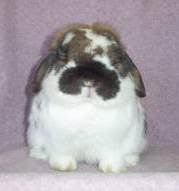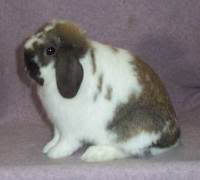Prices vary by breed, but this is how Laurie set her prices for Holland Lops from the former Nature Trail Rabbitry.
Learning how to set prices for your sale rabbits can be very difficult, especially when you are starting out. There’s no substitute for experience, but I will share some of my philosophy to give you something to think about.
I don’t pick prices for my rabbits out of thin air. There’s an informal system I use to set my prices. I work best when things make some sense to me. And this way of thinking about pricing has worked for me.
Set a base price to work from
First of all, think about the various categories of Hollands you sell:

* pet quality
* brood quality bucks (either true or false dwarf)
* brood quality does (either true or false dwarf)
* show quality bucks
* show quality does
* herd buck quality
I’ve placed them in the order that I value them from least to most, but you don’t have to agree with this arrangement. Nor do you need to have the same categories. You may have a 4-H show quality category, for example. Or you might think there’s no difference between a show quality buck and herd buck quality. Your list just needs to make sense to you.
Next to each type of rabbit that you sell, write down how much you think the typical example of that quality from the bloodlines you work with is worth. I’m going to use some outrageous amounts, just as examples:
* pet quality – $7 (remember, these are bogus amounts)
* brood quality bucks – $10
* brood quality does – $15
* show quality bucks – $25
* show quality does – $25
* herd buck quality – $40
Tailor the price to the individual rabbit
Now I’m ready to evaluate my rabbit. First, I determine which category he or she falls in to get a starting price. Now I think of the things that might raise the price:
* from popular/exceptional bloodlines
* an especially nice example of that category
* good age (e.g., a brood doe old enough to produce is worth more than a 10 week old, or a buck in his prime showing years is worth more than a 6 year old that may stop breeding soon)
* legs or good placements at regional and/or national shows
* rare color
* for does, proven (not such a big deal for bucks)
* produced nice offspring
* is strong in a characteristic that is hard to get right
* broken pattern (small consideration, but still a consideration, especially for does)
* I am willing to deliver him or her to a wide range of locations (that means that I have a larger market)
* I am willing to wait for the right buyer
Of course, I also have to weigh any negatives:

* ancestors had uneventful show careers
* poorer than average example of the category (but still good enough for the category), considering faults, conditioning, lack of conformation
* getting older
* problematic litters (should be disclosed)
* health issues (should be disclosed)
* genetic risks (should be disclosed)
too young to really evaluate potential
* disqualifications (for brood stock – cannot be show stock with DQs – should be disclosed)
* variety and type are very ordinary (an average quality solid tort senior buck is pretty common)
* Charlie
* time of the year – sales for me are dead, practically, in July and during the holidays
* I want to sell this rabbit very soon
* I will not be traveling to many shows where I can deliver the rabbit (smaller market)
So let’s say that we have a brood quality doe and we start her price off at $15. But she’s a sable point so we add a few dollars. She’s unproven, so that keeps the price the same. She’s too young to really evaluate her potential, so we knock a few dollars off for that. She has long ears, more dollars off. But she has wonderful shoulders – width, length, and depth, which is difficult to come by. So we add a few dollars more for the great shoulders.
Or perhaps we have a brood buck. He’s an exceptional rabbit except that he’s a false dwarf and weighs 4.04. So we start him at $10 but add a few dollars for his exceptional conformation. Then we consider that he’s proven and has sired several really nice bunnies. Add a few more dollars. Now we had to this that he carries dilute and the sable gene, and we might add another dollar or two. He’s 17 months old, so he’s in his prime, age wise. He’s a Charlie, so that might bring his price down just a tad, simply because there are fewer people who know how to make the most of a Charlie in their herd.
[Although, it is true that Charlies are more limited in functionality than brokens (it is difficult to line breed with Charlies because their offspring are all broken and a line breeding results in 50% Charlies), having a few Charlies in your herd will help you keep the production of brokens in line with the production of solids in your barn.]
As you can see, there’s still a lot of judgment in pricing a rabbit, even using a “system.” But having a starting place and a list of considerations does help me a great deal. I hope it will help you, too.

Next Article: When selling rabbits you bought…
